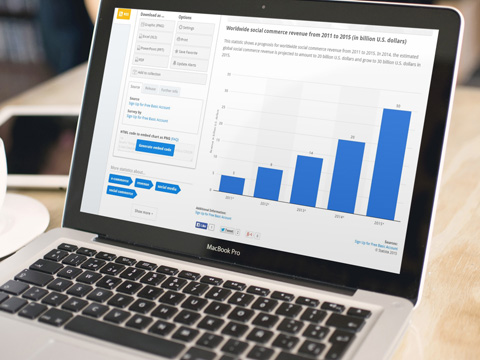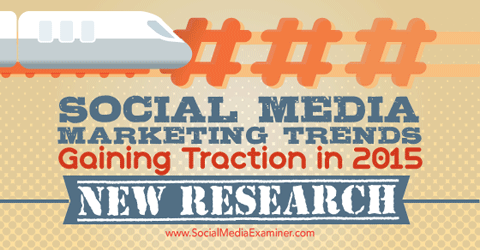Do you track social media marketing trends? Are you wondering whether predictions for 2015 are proving true? In this article you’ll discover findings from recent studies to help you gauge whether your social media marketing choices are on track. Thanks to Suzanne Delzio for writing this article.
#1: Sales Through Social Media Are Rising
For years now, marketers have reported their greatest social media frustration as tracking sales through to social media efforts.
A Facebook post or YouTube video might play a part in a sale at some point, but a phone call, filling out a form and other steps typically get the credit for moving potential consumers down the funnel. These steps are closer to the conversion. This difficulty giving social presence any sales credit prompted marketers to switch their social metrics from direct sales to the more amorphous metrics of brand awareness and buzz.
New research, however, indicates that social media may finally be directly delivering the paying customers vendors have longed for.
Internet Retailer’s “2015 Social Media 500,” a study of 500 leading merchants’ use of social media, reveals that retailers’ increased efforts to build social media audiences (follower numbers were up an average of 33% on Facebook from 2013 to 2014) are paying off.
In 2014, total social commerce sales that could be tracked to social networks hit $3.30 billion, up 26% from 2013’s $2.62 billion, which is quite a leap. The study also revealed that overall traffic to retailer websites originating from social networks ticked up 7%. Could these increases be the long-awaited indicators that social selling will finally take off?
A positive trend in social selling has been echoed by other reputable studies. According to leading statistics provider Statista, by the end of 2015, social selling will amount to $30 billion worldwide, a 50% increase over 2014’s $20 billion. (Keep in mind that the Internet Retailer study above gauged only 500 selected retailers, not the entire market, hence the difference between $3 billion and $30 billion.)

Leading research and statistics provider Statista predicts a 50% gain in social commerce revenue from 2014 to year-end 2015. Image: Placeit.
Key Takeaways: Many marketers will remember the early 2000s when doubt and suspicion surrounded online Christmas shopping. When online gift sales accounted for 5% of all sales, headlines like “Can It Last?” and “Trend or Here to Stay?” abounded.
Fast-forward to Christmas 2014 and Internet sites are the number-one place consumers go to buy gifts. Discount department stores like Walmart were a close second. Could social selling follow a similar trajectory?
If it’s just a matter of work, social selling could get a solid foothold worldwide.
Twitter, Facebook and Pinterest (and even Amazon.com) are busy developing buy-type buttons and promotions to help marketers track sales directly to the platform. Pinterest is already gaining traction as an ad platform with its rollout of promoted pin native ads. Provable ROI for social media will mean more budget attributed to it. Networks design these buy buttons to reduce the steps it takes for website visitors to buy items from the store.
Social platforms are clearly aiming for revenue that isn’t only ad-based. Does that mean social media will become more like an affiliate, taking a small portion of every sale they send to a vendor?
Also, some experts warn that social media’s primary role as a relationship facilitator will be damaged if too much commerce comes in. Most likely, consumers will vote on the compatibility of shopping and social media with their dollars.
#2: Social Media Consumption Exploding on Mobile… But Don’t Write Off Desktop
The long-predicted mobile tsunami has finally landed on U.S. shores. Digital research giant comScore’s March 2015 study “U.S. Digital Future in Focus” provides perspective because of its four-year view.
It reveals that mobile access to the Internet has quadrupled over the past four years, and desktop has risen 37%. (Because tablet Internet access began with almost no share in 2010, it increased by almost 1,800%, mostly because tablet adoption increased exponentially in a short period.) The study also found that the predominant Internet activity on mobile was social networking.
Mobile’s new domination of social media activity did not sap numbers and minutes from desktop digital time, however. Instead, digital time seeped into Americans’ off-hours, as they brought their smartphones and tablets to television time, waiting rooms, Starbucks’ lines and bed. Consumer access grew, allowing for mobile to capture more eyeballs.

Many are excited that social media access via mobile quadrupled in the past four years. Image: Shutterstock.
Many are excited that social media access via mobile quadrupled in the past four years. Image: Shutterstock. The same study found that approximately 31% of all traffic to the top 10 digital properties was mobile-only visitation. For example, Facebook is the number-three digital property, getting 207 million unique U.S. visitors. Google and Yahoo! are numbers one and two.
In fact the authors of the comScore study relate that, “Facebook saw mobile revenues surpass desktop revenues, signaling a shift towards mobile as the primary digital media platform.” Keep in mind that with 31% accessing Facebook through mobile, device usage is not primary yet. The “shift” mentioned by the comScore study authors is “towards” mobile.
Research firm eMarketer explains that U.S. adults have switched their social activity from desktop to mobile. The company predicts that by the end of 2015 more than half of all social networking will occur on smartphones and tablets.
Key Takeaway: The long-predicted mobile shift has occurred. The comScore study authors conclude:
Perhaps more so than at any other time in recent memory, changes were not merely incremental but rather seemed to represent key inflection points in the evolution of various markets and behaviors.
Businesses that can make their offers succinct and complete orders without too much thumbing activity have the best chance of success.
#3: Podcasting Is Gaining Ground
With 44% of Americans now listening to streaming audio (Pandora, Spotify, etc.), similarly structured, on-demand podcast episodes are also gaining ground. The popularity of weekly NPR true-crime podcast Serial has won marketers’ attention.
Podcasting blurs the line between content marketing and social. It’s content because of the useful information or entertainment it provides; it’s social because it provides personal interaction with one of the voices of a brand.
Listeners can call in and/or podcasters can answer questions sent via email or social. Podcast landing pages are typically enabled with social buttons for easy sharing, liking and commenting. Podcasters also entice their audiences to follow and friend them on social media.
In March 2015, Edison Research and Triton Digital released “The Infinite Dial 2015,” their study of the digital consumption habits of 2,002 Americans. Monthly audio podcast consumption grew from approximately 39 million monthly users in 2014 to approximately 46 million in 2015, an increase of 18%.
Tom Webster, vice president of strategy and marketing for Edison Research, explains:
Online radio has become mainstream; podcasts are enjoyed by a significant portion of the population.… It’s vital for marketers and advertisers to understand and plan for these shifts.
Particularly because these shifts involve audiences that, while perhaps just medium-sized, earn a decent wage and prove loyal to and even engaged with their shows.
A February 2015 snapshot of the top 100 podcasts by online news magazine FiveThirtyEight revealed that 87% of podcast sponsors are mid-tier, dot.com companies selling web-based services (subscription) or ecommerce products (Dollar Shave Club). Surprisingly, one-third of the podcasts had no sponsors at all, indicating that the host was most likely selling his or her own products or services.
Still, seeing the high net income of podcast listeners did entice Goldman Sachs, Geico and a few other big brands to stick their toe in with just one ad each in FiveThirtyEight’s two-day timeframe for the study.
The typical podcast advertisement consists of the host speaking into the microphone, in the manner of many talk radio hosts, singing the praises of a brand. It’s not an agency-produced piece.
Key Takeaway: With few big brands advertising on podcasts and a full 38% of podcasts free from brand advertisement, opportunities exist to experiment with advertising on shows at as-yet reasonable rates.
#4: Facebook Continues to Dominate, Particularly on Mobile
Extending a trend several years in the making, Facebook not surprisingly still dominates social media. Facebook dominated desktop, and it doesn’t plan to let other channels get ahead of it in mobile either. In fact, Facebook saw and planned for consumers’ switch to mobile social networking from miles away.
Facebook’s addition of its trending tool and graph search to mobile intends to keep news-junkies on the app for longer. VentureBeat reports that Facebook also acquired LiveRail, a video advertising company, with the aim of getting advertisers to put up video ads for targeted audiences. It also launched Audience Network, which puts Facebook ads on mobile apps that aren’t Facebook properties.
Application industry publisher App Annie reports that Facebook apps made up four of the top 10 most downloaded apps, taking spots one and two with Facebook Messenger and Facebook.
Customer data and insight provider Gigya reports that in Q4 2014, Facebook not only became the provider of 61% of all social logins, but also makes up 72% of all ecommerce social logins (also called identity providers). Facebook’s 61% stretches far ahead of Google+’s second runner-up status at 22%. Note the big blue slice below.
And finally, Pew Research tells us that Facebook’s engagement rate far outstrips that of any other social channel. Seventy percent of its huge user base engages with the site daily. That number increased 7% from 2013, and beat Instagram’s daily user number of 49% and Pinterest’s 17% thoroughly. Those two platforms did not increase their daily user rates from 2013 to 2014.

Pew Research, too, reports that Facebook gets the most attention from American adults. Image: Placeit.
Key Takeaway: So far ahead on mobile and with the capital to continue its pattern of frequently offering new mobile features, Facebook diminishes other mobile social networking platforms. Its free features make users’ lives so much easier that they’re happy to share all of their buying intent, demographics, purchase history and more.
This means advertisers will see Facebook as providing the most targeted and valuable audience, an avalanche of eager consumers. Facebook can ask for top dollar for its ads. So much for the death of Facebook!
What do you think? Did you see these trends coming? What surprises you? Will you explore podcasting or how your company can use Facebook and other channel buy buttons? Leave your comments and questions below.
Money thumb photo, Revenue photo, Man in cafe photo, Podcast photo, Online radio photo and Facebook photo from Shutterstock. Statista and Pew study images created with Placeit.
This article was originally
published by Suzanne Delzio on
SocialMediaExaminer.com
This content is syndicated news that can be used for your research, and we hope that it can help your productivity. This content is for educational purposes and is not made for any kind of commercial purposes of this blog.








